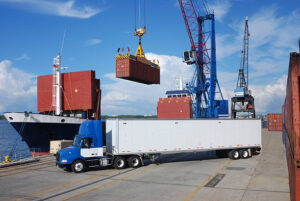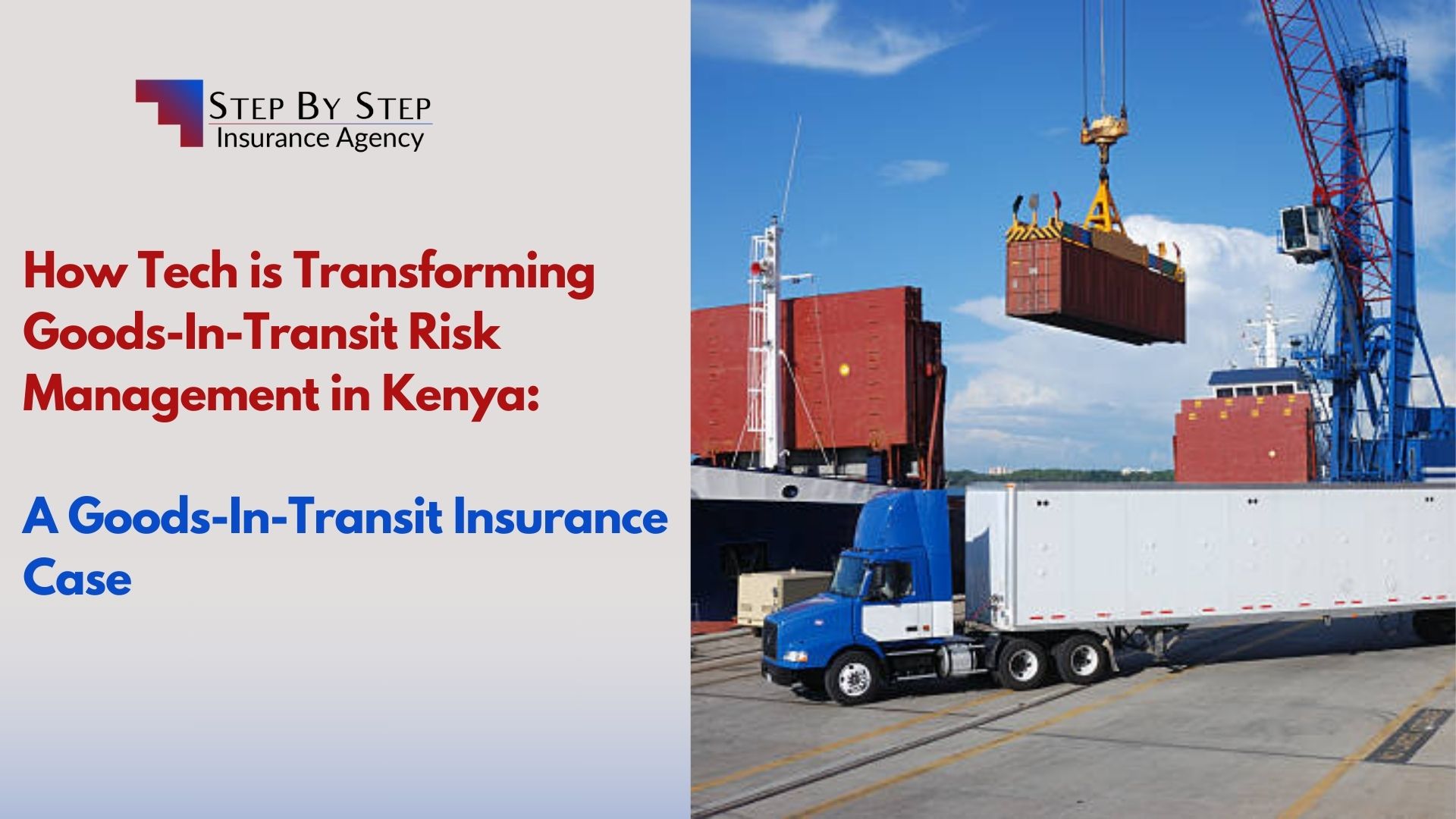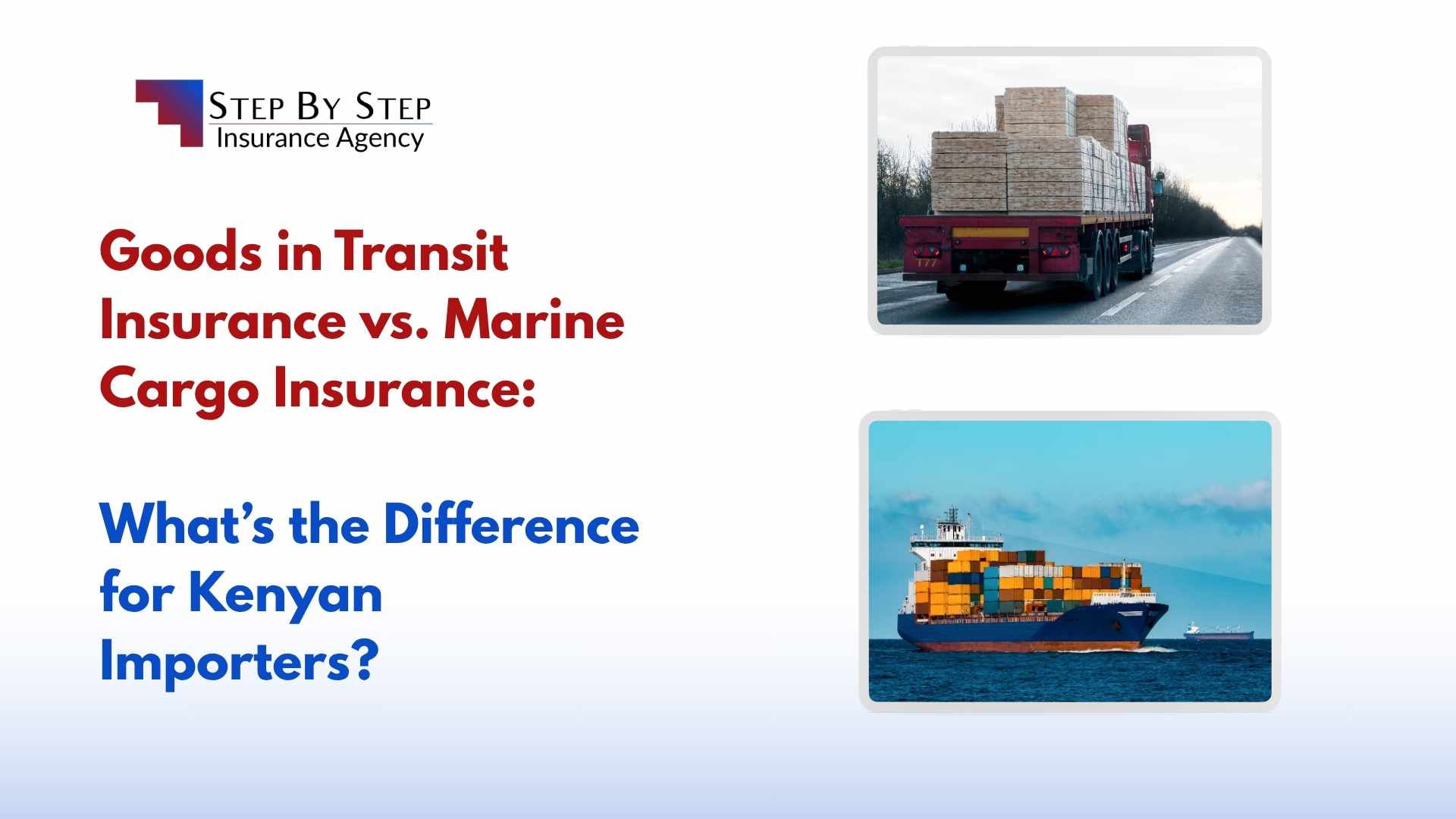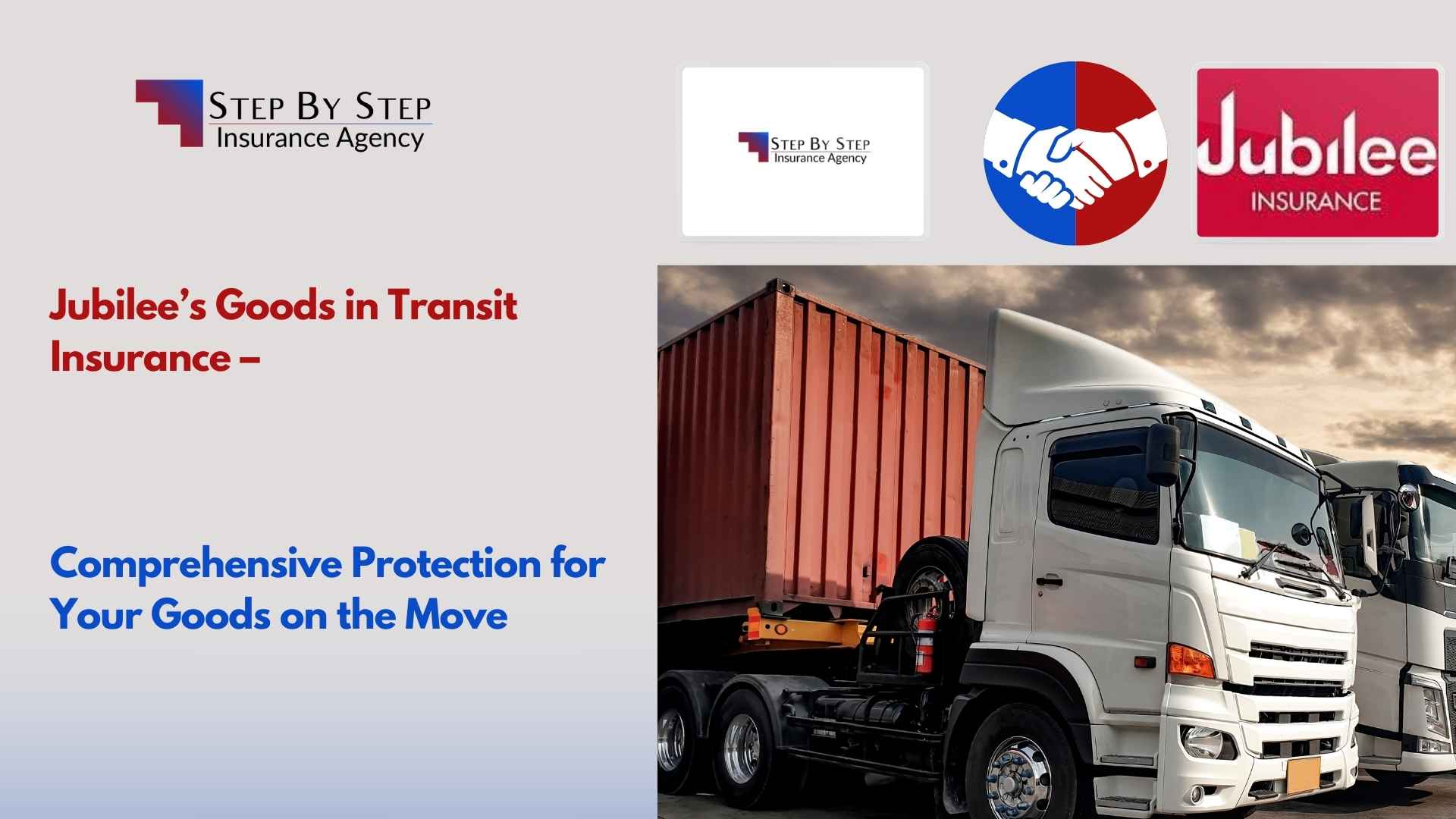How Tech is Transforming Goods-In-Transit Risk Management in Kenya: A Goods-In-Transit Insurance Case
Introduction
Kenya’s logistics sector has grown significantly in recent years, driven by expanding e-commerce, infrastructure development, and increasing regional trade. But as more goods move across countries and borders, risks like theft, damage, and accidents have also escalated. Businesses from large distributors to bodaboda couriers face daily exposure to these risks. This is where Goods-In-Transit (GIT) Insurance becomes not just a smart decision, but a business necessity.

However, the insurance landscape is also evolving, especially with the integration of technology in logistics and insurance operations. From real-time GPS tracking to AI-powered claims assessment, technology is not only mitigating risk but also reshaping how GIT insurance works.
In this article, we explore how tech is transforming goods-in-transit risk management in Kenya, what must-haves and should-haves every policyholder should consider, and how Step By Step Insurance Agency is playing a critical role in educating and supporting businesses through these changes.
Key Takeaways
- Tech such as GPS, telematics, and AI is transforming how GIT risk is managed in Kenya.
- Businesses benefit from better route control, driver monitoring, and faster claims resolution.
- GIT insurance must include theft, accident, and driver liability protections.
- Advanced features like revenue loss and cross-border cover provide extra security.
- Step By Step Insurance Agency offers expert, tech-aligned GIT insurance solutions.
Table of Contents
- Introduction.
- The Evolution of Goods-In-Transit Insurance in Kenya.
- The Role of Technology in Goods-In-Transit Risk Management.
- Technologies Revolutionizing Goods-In-Transit Risk Management.
- Goods-In-Transit Insurance Must-Haves in Kenya.
- Goods-In-Transit Insurance Should-Haves.
- Step By Step Insurance Agency: Your Trusted GIT Insurance Advisor.
- Conclusion: Future-Ready Logistics and Insurance in Kenya.
The Evolution of Goods-In-Transit Insurance in Kenya
Traditionally, GIT insurance in Kenya was paper-based, reactive, and somewhat limited in customization. Policies were generic, and claims processing could take weeks. Logistics companies, suppliers, and manufacturers often relied on vague terms, minimal risk profiling, and reactive compensation after a loss.

Today, things have changed. Modern underwriters are increasingly leveraging data to better understand risk. Logistics companies are partnering with tech providers to reduce exposure through preventive tools. And most importantly, insurers are beginning to recognize the value of integrating tech-driven insights into pricing, claims, and underwriting processes.
This evolution is also fueled by the rise of insurtech and demand for faster, more transparent service delivery.
The Role of Technology in Goods-In-Transit Risk Management
Transporting goods across Kenya’s roads, whether between counties or across borders, is a high-stakes operation. From unpredictable weather to traffic accidents, theft, and road conditions, the risks are many and often costly. Traditionally, businesses have relied on insurance to pick up the pieces after a loss. But today, the game is shifting from reaction to prevention, thanks to technology.
Technology is no longer just a convenience, it’s becoming a core pillar of risk management in logistics. From tracking trucks in real time to using data to predict potential threats before they occur, tech tools are giving both businesses and insurers the power to make smarter, faster, and more informed decisions.
In this section, we look at how technology is not just supporting logistics but actively transforming how risk is identified, reduced, and managed in goods-in-transit operations. Whether you’re a fleet owner, courier, or insurer, these tech-driven strategies are now essential for staying ahead of the curve.
The key role of tech lies in:
- Monitoring goods in real-time
- Predicting and preventing losses
- Improving claims speed and accuracy
- Enhancing transparency between client and insurer
- Optimizing delivery routes for safety and speed
By integrating tech into logistics and insurance, businesses can anticipate and mitigate risks before they occur, shifting from reactive insurance to proactive risk management.
Technologies Revolutionizing Goods-In-Transit Risk Management
In today’s fast-paced logistics landscape, the old ways of managing transit risks, manual logs, reactive problem-solving, and delayed communication are no longer enough. Businesses transporting goods across Kenya’s vast road network face rising threats: highway robberies, driver misconduct, route inefficiencies, and poor cargo handling, to name just a few.
But thanks to rapid advancements in technology, the game is changing.
A new wave of smart tools ranging from GPS tracking systems to artificial intelligence, are enabling businesses and insurers to predict, monitor, and mitigate risk in real time. These innovations are not only safeguarding cargo, but also transforming how insurance is priced, how incidents are responded to, and how quickly claims are settled.
Below, we dive into the specific technologies that are revolutionizing goods-in-transit risk management in Kenya, and why embracing them isn’t optional, but essential for staying competitive and secure.
GPS Fleet Tracking
GPS technology allows businesses to monitor the exact location of their vehicles and goods in real time. If a truck deviates from its assigned route or stops unexpectedly, the system alerts the fleet manager immediately. This reduces the chances of theft and increases delivery reliability.
For underwriters, GPS data provides essential insights into route safety, travel time, and behavioral trends of drivers, which helps in pricing and policy customization.
Telematics and IoT Sensors
Telematics devices capture data on driving behavior, speed, braking, idling, and more. IoT sensors can monitor temperature (for perishables), vibrations (for fragile goods), and door openings (to detect unauthorized access).
These insights allow logistics firms to enforce better driver training and cargo handling practices, while insurers use the data to assess claims more objectively and encourage safe practices through premium discounts.
Geofencing and Route Mapping
Geofencing enables businesses to create virtual perimeters. If a truck or boda goes outside its designated area, alerts are triggered. Combined with route mapping software, geofencing allows dispatchers to ensure drivers stick to safe, approved routes.
This technology is particularly valuable in high-risk areas where cargo theft is common, such as remote or poorly lit roads.
Digital Documentation and Claims Processing
Gone are the days of endless paperwork. Today, GIT claims can be filed digitally with photo evidence, timestamps, and automated forms. Blockchain is even being tested to secure documentation.

This accelerates the claims process and improves client satisfaction. It also eliminates the chances of fraud and document tampering.
AI-Powered Risk Assessment
Artificial Intelligence enables insurers to assess risk using real-time and historical data. AI models can predict the likelihood of loss based on route, type of cargo, time of day, and even weather conditions.
This leads to more personalized premiums and early detection of high-risk factors before a trip is made.
Goods-In-Transit Insurance Must-Haves in Kenya
Not all Goods-In-Transit (GIT) insurance policies are created equal and in Kenya’s fast-moving and sometimes unpredictable logistics environment, the right cover can mean the difference between a small setback and a major financial disaster.
Whether you’re moving electronics from Nairobi to Kisumu, farm produce from Eldoret to Mombasa, or construction materials to a site in Kitengela, you need a policy that covers more than just the basics. Unfortunately, many businesses discover the gaps in their cover only after something goes wrong.
That’s why understanding the must-have features of a GIT insurance policy is critical. These are the foundational protections that every business transporting goods should insist on regardless of size, sector, or route.
Let’s break down the non-negotiables that make your GIT insurance truly reliable, practical, and ready for the Kenyan market.
All-Risk Cover:
Protection from loss or damage caused by fire, theft, accident, or natural disasters.
Clear Declaration of Goods:
Ensure all cargo types and values are correctly stated.
24/7 Claims Support:
Fast access to help when incidents occur.
In-Transit Theft Cover:
Many losses happen during stopovers or traffic to make sure it’s covered.
Driver Liability Extension:
If the driver is at fault, this extension protects the business owner.
Goods-In-Transit Insurance Should-Haves
While the essentials of Goods-In-Transit (GIT) insurance offer solid protection, businesses that go the extra mile often gain a competitive edge. In Kenya’s evolving logistics space where delays, cross-border trips, and unexpected losses are all too common, basic cover might not be enough to keep your operations fully secure.
That’s where the “should-haves” come in.
These are the valuable add-ons and policy enhancements that, while not mandatory, offer smarter protection, better financial cushioning, and greater peace of mind. They help cover the grey areas that standard policies often miss like lost revenue from delays or the complications of transporting goods into neighboring countries.
If you’re serious about building a resilient, future-proof logistics business, these extras are worth considering. Let’s explore the key should-haves that can elevate your GIT insurance from standard to strategic.
Loss of Revenue Compensation:
Covers potential loss of income due to delayed or damaged goods.
Third-Party Cover:
Extends protection to other parties affected in an incident.
Cross-Border Transit Cover:
For businesses transporting goods into Uganda, Tanzania, or Rwanda.
Emergency Response Services:
Includes towing or security assistance in case of breakdowns.
Integration with Fleet Tech:
Some insurers now offer discounts for GPS-tracked or IoT-enabled fleets.
Step By Step Insurance Agency: Your Trusted GIT Insurance Advisor
At Step By Step Insurance Agency, we understand the dynamics of Kenya’s roads, markets, and the evolving risks businesses face daily. Our role goes beyond simply connecting you with underwriters. We walk with you to identify the best cover based on your business size, goods type, routes, and logistics setup.
We also help businesses integrate their insurance strategy with modern fleet technologies, offering consultation on:
- How to understand GIT premiums, and the fine print.
- Choosing underwriters that support GPS-integrated claims.
- Real-time claims reporting and settlement support.
- Policy reviews that reflect your business’s growth or changes.
Whether you’re an SME delivering fast-moving goods across counties or a large distributor operating in East Africa, Step By Step is here to help you mitigate risk and move with confidence.
Conclusion: Future-Ready Logistics and Insurance in Kenya
The future of logistics and insurance in Kenya is intertwined with technology. As businesses scale operations and expand their delivery reach, managing risk becomes more complex and more essential. Embracing GPS tracking, IoT sensors, and AI-driven analytics isn’t just a tech trend, it’s a strategic move toward operational resilience.
Insurance too must keep pace. Gone are the days of generic, static policies. Today, GIT insurance must be dynamic, tailored, and backed by data-driven insight. With the right tools and partners, you can not only insure your goods but ensure your business keeps moving forward.
At Step By Step Insurance Agency, we believe that risk should never hold you back. Let us help you navigate Kenya’s roads with peace of mind, expert advice, and the right protection step by step.
Reach out to Step By Step Insurance Agency for a FREE quote and consultation:
Call: 0729712200 / 0716534192
WhatsApp: 0722888350
Email: info@stepbystepinsurance.co.ke
Website: stepbystepinsurance.co.ke/
#GoodsInTransit #KenyaLogistics #Insurtech #SupplyChainSecurity #StepByStepInsurance #FleetTracking #InsuranceKenya #DigitalLogistics #BusinessRiskManagement






Latest News on Insurance in Kenya (from May 22, 2025) - Step By Step Insurance
May 22, 2025 @ 3:19 pm
[…] is particularly focused on enhancing digital insurance services, including the implementation of AI-powered features on its CarDuka vehicle marketplace and expanded online platforms specifically designed for SMEs and […]